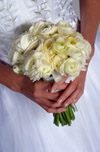





 |
 |
 |
 |
Monday, January 08, 2001
The Hidden Language of Wedding Flowers
Symbolically, flowers have come to represent different things throughout the years. Many brides choose flowers for their wedding that have sentimental value. Perhaps it was the first flower she received from her fiance or maybe the flower her mother carried down the aisle at her wedding. For brides who want to create their own tradition, the meanings of individual flowers can help with the decision. One of the more traditional flowers most often used at formal weddings is the rose. This customary flower's colors represent many different emotions and the rose is the most widely given flower in the name of love. A red rose represents passionate love; a white rose represents pure love; a pink rose represents innocent love; and a yellow rose symbolizes friendship. Brides today are straying away from tradition, and that includes flowers. Some of the more non-traditional flowers have also come to represent certain feelings and emotions. The beautiful gardenia symbolizes joy while the lacey Lily of the Valley is related to happiness. For a regal feel at your wedding, purple lilacs - which represent regal unity - might be appropriate. The softness of a white lilac is often related to youthful innocence, while the strong aroma of forget-me-nots may convey the feeling of true love during your nuptials. Along with the expression of emotions, the flowers you choose for your wedding should also coordinate with other items. The shape, size and style of the bouquet should compliment your dress and you. Whatever flowers you choose, be sure that the bouquet is well constructed to ensure that it lasts all day. The attendant's flowers usually compliment the bridal bouquet as well as their dresses. For a more romantic feel, flower headdresses are the perfect addition to your own wedding attire. A traditional circle of flowers or small additions in any pattern or shape to suit your hairstyle is another way to incorporate your flower theme of choice into the day. Grooms, best men and ushers should also accessorize with the use of buttonholes, continuing the same theme or pattern of the bride and her attendants. However you incorporate flowers into your wedding day, the budding blooms convey a plethora of messages all their own. Whether it's their traditional meaning, a distinct aroma or colorful petals, the language of flowers at a wedding is identical to the language of love. Courtesy of ARA Content, www.aracontent.com, e-mail: info@aracontent.com
 (ARA) - Almost every wedding today is graced with flowers. From the bride's bouquet to the church's pews, flowers have become a way of expressing a couple's individuality and adding beauty to an already extraordinary event. Flowers are not only an extension of the bride and grooms personality, but they express a language all their own, and incorporating their beauty throughout the wedding takes planning and a short lesson in the language of flowers.
(ARA) - Almost every wedding today is graced with flowers. From the bride's bouquet to the church's pews, flowers have become a way of expressing a couple's individuality and adding beauty to an already extraordinary event. Flowers are not only an extension of the bride and grooms personality, but they express a language all their own, and incorporating their beauty throughout the wedding takes planning and a short lesson in the language of flowers.
